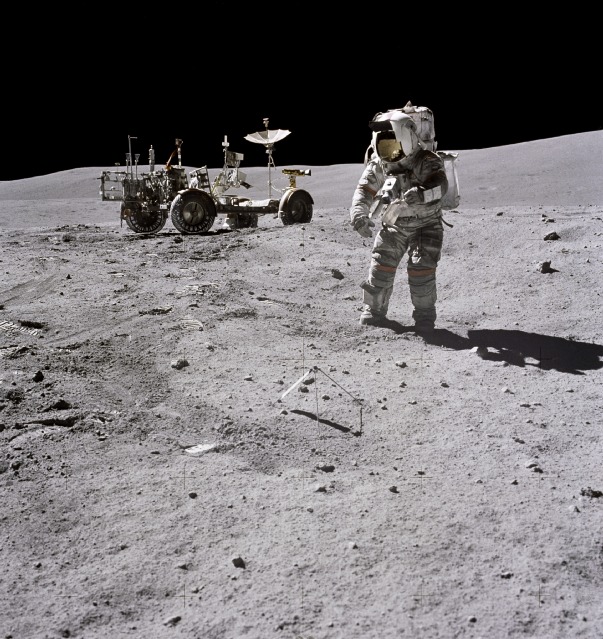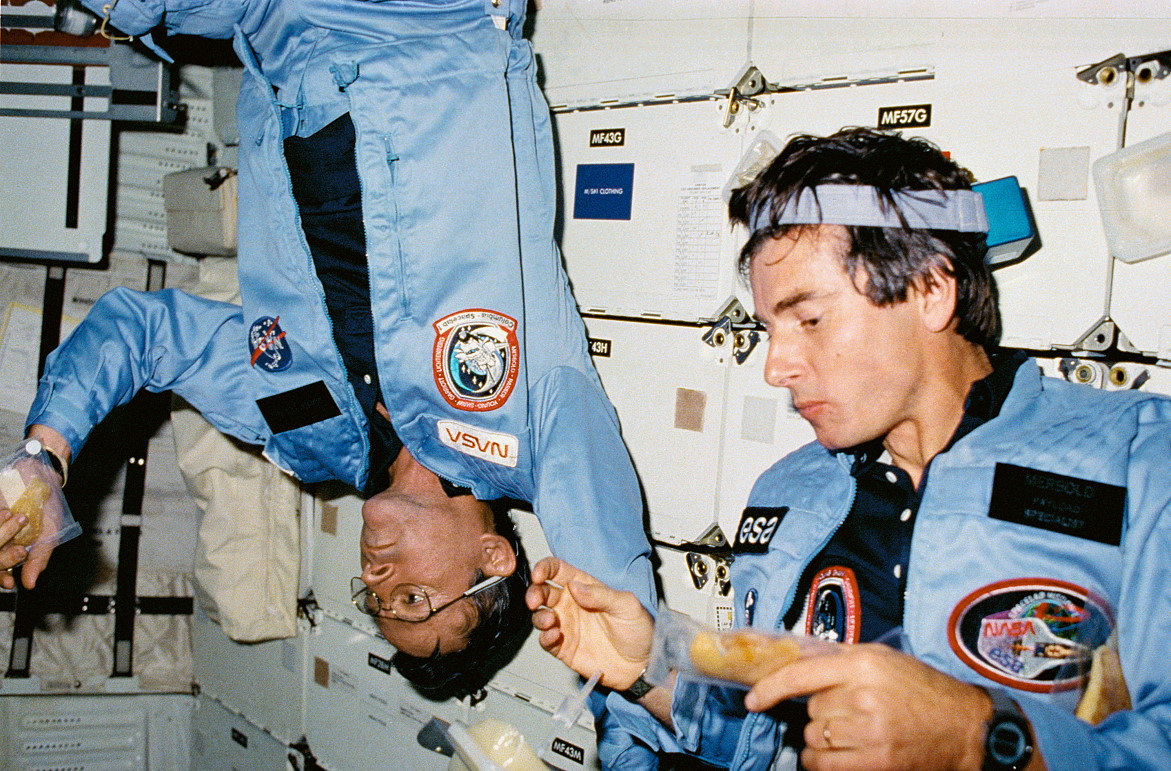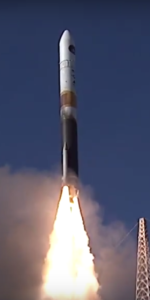
Astronaut John Young, who died recently at age 87, reduces yet further the number of veteran Moonwalkers who are still with us. Only five men—all in their 80s—can now claim to have experienced the one-sixth gravity of the lunar surface and to have glimpsed its desolate landscape through their space suit visors. For more than four decades, from his selection as a NASA astronaut in September 1962 to his retirement in December 2004, Young was a titanic figure in the halls of the space agency, launching seven times, flying six discrete space missions, performing three lengthy Moonwalks, voyaging twice to lunar distance and becoming the longest-serving chief of the Astronaut Office. Young’s legacy extended far beyond his missions. His leadership, his humor, his focus and tenacity, his unflappability under duress and an unwavering devotion to flight safety turned him into what veteran shuttle flier Tom Jones once described as “the conscience of the astronaut corps”.
Young’s reputation as an unsurpassed leader, engineer and aviator long predate his time at NASA. In the early 1950s, as a Navy ensign, he was fire control officer aboard the destroyer USS Laws, during the Korean War. One of his former crewmates remarked that when the ship sustained counter-battery fire, with rounds striking their position, it was Young’s cool leadership which enabled them to respond, return the enemy fire and win the day. Years later, as a test pilot, he worked on weapons systems for the F-4H Phantom fighter at the Naval Air Test Center at Patuxent River, Md., when he and another aviator approached each other’s aircraft at more than three times greater than the speed of sound. “I got a telegram from the Chief of Naval Operations,” Young later quipped, “asking me not to do this anymore!”

His six missions as an astronaut brought more than their fair share of drama. Twenty minutes into his first flight, as pilot of Gemini 3 in March 1965, Young noticed the oxygen pressure gauge suddenly drop. At first, he suspected a malfunction, but his attention was soon drawn to other problems, which indicated a power supply failure. Quickly, he switched from the primary to the backup electrical converter, which powered Gemini 3’s dials, and the glitch vanished. From the moment he spotted the problem, to its resolution, only 45 seconds elapsed. Then, during re-entry, a violent parachute reconfiguration pitched both Young and command pilot Virgil “Gus” Grissom into their forward-facing windows. The impact cracked Young’s visor.
The dramas continued until the very end of his career. In December 1983, as he prepared to bring shuttle Columbia back to Earth at the end of STS-9, Young and pilot Brewster Shaw were faced with not one, but two failures of the on-board General Purpose Computers (GPCs). The mood among the astronauts was tense. “My knees started shaking,” Young told the post-flight press conference. “When the next computer failed, I turned to jelly. Our eyes opened a lot wider than they were before!” Even STS-9’s landing posed its share of heart-stopping moments. After Young and Shaw had brought Columbia smoothly onto the runway at Edwards Air Force Base, Calif., a fire broke out in one of the Auxiliary Power Units (APUs). In the words of Acting NASA Administrator Robert Lightfoot, Young’s handling of this end-of-mission emergency underscored his “test pilot cool”.

His attitude towards flight safety was unrivaled. Unlike most other spacecraft, Gemini spacecraft did not have an integrated launch escape tower and instead pilots would be boosted out of the capsule in ejection seats in an emergency. Young once watched a Simulated On-Pad Ejection (SOPE) test, when the overhead hatch failed to open and the seat was fired straight through the spacecraft’s 2-inch-thick (5 cm) metal hull. Had such a situation occurred for real, the astronaut would have been killed. “That’s one hell of a headache,” Young remarked, “but a short one.” It was unsurprising, therefore, that on Gemini 3 Young sat calmly throughout his first ascent to space, with his hands folded in his lap, never touching the ejection seat handle. Many other Gemini fliers agreed that the dangers of using the ejection seats were not worth the risk.
Dovetailed into this was his top-notch technical knowledge. In his recent memoir, Endurance, veteran astronaut Scott Kelly remembered being interviewed by Young and asked about the frequency response of the longitudinal flight control system in the F-14 Tomcat fighter. “I had been tipped-off by an F-16 pilot, who interviewed the same week as my brother,” Kelly wrote, “that Capt. Young liked to ask about longitudinal frequency response.” In Kelly’s mind, it was a means for Young to test his technical knowledge, but there was something else, too. “I think he was just fascinated by planes and never stopped wanting to learn about them.”

Young became chief of the Astronaut Office in April 1974 and held the position until April 1987, longer than any other incumbent. During that time, and afterwards, he maintained a presence at the office’s Monday morning meetings and welcomed dozens of new astronauts into the corps. Many of their opinions juxtapose his shyness with his incessant focus and devotion to duty. Jerry Ross, in his autobiography, Spacewalker, remembered Young often walking the halls of the Johnson Space Center (JSC) in Houston, Texas, looking down at his shoes, paying scant attention to what was going on around him. “He wasn’t an effusive type of manager,” wrote Ross, “but we admired his unrelenting dedication to our country’s space programs.” Jerry Linenger and Mike Mullane both remarked that he often spoke to his shoes, rather than to them, at meetings. There was also, added Canadian astronaut Chris Hadfield, a sense of awe around him. “When I was assigned to a desk beside John Young,” Hadfield later wrote, “I didn’t feel like I’d finally arrived. I felt like a gnat!”
Young’s rumpled appearance and country-boy drawl hid a keen analytical mind, as described by Apollo historian Andrew Chaikin in his landmark book, A Man on the Moon. Young would arrive for simulator sessions in shirt and jeans, sit through lectures without saying a word and the engineers would think him slow-witted. But they only ever make this mistake once, Chaikin wrote, for Young was one of the most responsible and intelligent astronauts on the team. When Young was worried about an engineering problem, his STS-1 crewmate Bob Crippen once remarked, “then I should be worried about it as well!” Even as a “rookie” astronaut, before Gemini 3, his opinions were respected. In his autobiography, Countdown, astronaut Frank Borman remembered Young going to Wright-Patterson Air Force Base, near Dayton, Ohio, where prime contractor McDonnell had installed a Gemini mission simulator aboard the KC-135 zero-gravity aircraft. Young disliked it and felt its displays were lacking in realism. Without further ado, the simulator was changed.

Young’s humor was legendary. On the day before his first flight aboard Gemini 3 in March 1965, he asked backup command pilot Wally Schirra to pick up a corned beef sandwich from a Cocoa Beach deli, called Wolfies. During the mission, Young turned to Grissom and asked: “You care for a corned beef sandwich, skipper?” Grissom was astonished and sampled the treat, complaining about its lack of mustard, but when flecks of rye bread began to float around the cabin he was obliged to put it away. The incident drew a mild reprimand after the flight, but for Grissom it was the highlight of Gemini 3, far tastier than the mission’s staple of apple sauce, grapefruit juice and chicken bits.
Never an excessive talker, Young’s second flight came in July 1966, commanding Gemini X with co-pilot Mike Collins. With two spacewalks, rendezvous with two different space vehicles, a climb to a then-record-setting altitude of 474 miles (763 km) and a ton of scientific and engineering activities, the two astronauts had little time or inclination for banter. At one stage, fellow astronaut Deke Slayton came on the radio and asked them to do a little more talking to Mission Control. Young’s response was typical. “Okay, boss. What do you want us to talk about?”

Three years later, in May 1969, he served as Command Module Pilot (CMP) of Apollo 10, flying to the Moon with crewmates Tom Stafford and Gene Cernan. During the mission, Young became the first human to fly solo in lunar orbit. “You’ll never know how big this thing gets when there ain’t nobody in here but one guy,” he remarked on the spaciousness of having the command module to himself. At one point, he watched Stafford and Cernan struggle with their lunar module, which momentarily began to gyrate wildly. “I don’t know what you guys are doing,” Young drawled, “but knock it off. You’re scaring me!”
Perhaps less palatable was his admission that he spent some of his solo time on Apollo 10 performing his first bowel movement in over five days. Later in the mission, when the lunar module Snoopy was discarded, it floated off into permanent solar orbit, carrying a United Nations flag, a small flag from each state of the Union, an unneeded docking probe, a pile of empty food packets…and a bag of Young’s fecal goodies. “We joked that Snoopy would have food, water, oxygen, organic material, all the ingredients for the creation of life,” Stafford wrote in his memoir, We Have Capture. “Maybe a few billion years from now, some kind of Snoopy monster, distantly related to John Young, will emerge from somewhere in the Solar System!”

In April 1972, Young commanded Apollo 16, during which he and Charlie Duke became the ninth and tenth men to walk on the Moon. Famously, their potassium-laced supply of orange juice caused a few gas problems. One evening, aboard the lunar module Orion, Young complained to Capcom Tony England about the effect of the orange juice on his intestinal tract. Unfortunately, he left his microphone button in the “On” position…and the entire world was treated to a frank conversation between two acid-stomached astronauts on the Moon. “I got the farts again, Charlie,” Young said. “I don’t know what gives ’em to me, I really don’t. I think it’s acid in the stomach, I really do.” After a short exchange between the astronauts, and a cuss word or two, England came online and told them that they were transmitting, hot-mike. An embarrassed Young made fewer remarks after that.
His humor, though, nicely balanced the enthusiastic zeal of Duke. One difficulty on the Moon was its lack of atmosphere, which made it notoriously difficult to judge distance. On one occasion, the astronauts spotted a large boulder and headed over to take a sample. Young thought it was further away than it really was, but Duke was convinced it was close. “Like everything else around here,” deadpanned Young. “A couple of weeks later…” He was right. Their lack of depth perception in an airless world had misled them. “House Rock” turned out to be, in Duke’s words, “humongous”, towering above them.

As well as jokes between crewmates, Young participated in humor on the ground, too. From July 1972, he trained with Duke and fellow astronaut Stu Roosa to backup Apollo 17. They jokingly grew mustaches and dubbed themselves “the only all-Southern Apollo crew”. Almost a decade later, before commanding the first Space Shuttle mission, Young commented to space suit technician Jean Alexander about the smallness of the U.S. flag on his shoulder. After getting him a suitably-sized flag, Alexander and the other suit-techs decided to prank. On launch morning, they talked a local real-estate office into lending them an enormous flag, which they put up in crew quarters, covering an entire wall. When Young walked in, the suit-techs asked him: “Okay, John, is that big enough?”
Aside from the humor, Young was always a champion for flight safety, throughout his time as an astronaut, in his role as chief of the office and in his subsequent position as Special Assistant to the JSC Director for engineering, operations and safety. In the aftermath of the Challenger accident, he was openly critical of NASA management, but the agency denied that his move off flight status was punitive in nature. Years later, Scott Kelly remembered him standing up at meetings to remark about the dangers of foam falling away from the shuttles’ External Tanks. “We have to do something about this,” Young said, “or a crew is going to die.” On 1 February 2003, the crew of STS-107 were killed during re-entry, a direct consequence of a catastrophic foam impact to Columbia’s left wing.

His attitude to flight safety was couched in his own dark humor. Describing the hairy Return to Launch Site (RTLS) abort profile—which would have required the shuttle to separate from the External Tank and travel backwards at seven times the speed of sound, ahead of an emergency landing back at the Kennedy Space Center (KSC)—Young once commented that it needed “continuous miracles, interspersed with acts of God” in order to work. Fortunately, an RTLS was never needed or performed outside the simulator.
He was aware of the dangers in space, too. Talking to Deke Slayton in the weeks before Gemini X, Young knew that if his spacewalking colleague Mike Collins encountered difficulties, there would be little option but to cut him loose. “There was no way,” Young later said, “if anything happened to somebody going outside a Gemini that you could get them back in.” The narrow seat and the complications of an inflated, rigidized space suit would have made it impossible for Young to reach over, pull Collins into the seat, with enough overhead clearance to close the hatch. In April 1972, driving on the Moon, Young cautiously pushed the lunar rover no faster than 3 mph (5 km/h), for fear of falling over a scarp or into a crater in the featureless, sun-bleached landscape.

Yet it was arguably STS-1—first flight of the shuttle—which was the most hazardous test flight ever conducted. All previous U.S. piloted spacecraft had been tested in an unmanned capacity, but the complexity of the shuttle made this inconceivably difficult. Shortly before launch, Young had no money, so fellow astronaut Joe Allen bought him lunch in the JSC cafeteria. “We got in the car and John reached in his flight suit and he took out the money and he gave it to me,” remembered Allen. Laughing, Allen refused to accept it. But Young was insistent. “You don’t go fly these things when you got debts.” Then Allen realized that Young was right. “He was correct, and I was correct to accept it, so he had no debts.”
That said, Young’s calmness was astonishing. During the STS-1 ascent in April 1981, his heart rate peaked at 90 beats per minute. After the mission, he quipped that he was so old that his heart would not beat much faster, but Flight Director Neil Hutchinson had another explanation: the icy-cool commander must have been asleep the whole time!
Young’s focus on exploration and pushing the envelope was also apparent, throughout his career. In his autobiography, Chasing Space, veteran astronaut Leland Melvin recalled Young offering a few words of advice. “Leland,” he said, “once we stop exploring, as a civilization, we will fail!” In the weeks preceding Gemini X, Young approached senior managers with a view to extending his mission to its full consumables limit and in early 1972 he pushed hard to have a fourth Moonwalk added to Apollo 16. Both, unfortunately, were fruitless. He also wanted to carry a 100-foot-long (30-meter) tether on the mission, to allow himself or Duke to lower the other into the yawning bowl of North Ray Crater to gather samples. However, nervous mission managers nixed this idea.
Many astronauts have labeled John Young as “the Astronaut’s Astronaut” and he led the way over more than four decades of human space exploration. His leadership was highlighted on 23 March 1965, as he returned from his first mission. Command pilot Grissom was first to leave the Gemini 3 capsule, having suffered seasickness, and Young kidded him about his failure to adhere to the old adage about captains being the last to leave. Without missing a beat, Grissom retorted: “I just made you captain as I got out!” Never were truer words spoken.
FOLLOW AmericaSpace on Facebook!
.






Ben, you have once again done a great service to your readers with the magnificent, two-part tribute to John Young. I sincerely hope that the remaining moonwalkers will be around for the 50th anniversary of Apollo 11, and sad that we have not yet returned thete.